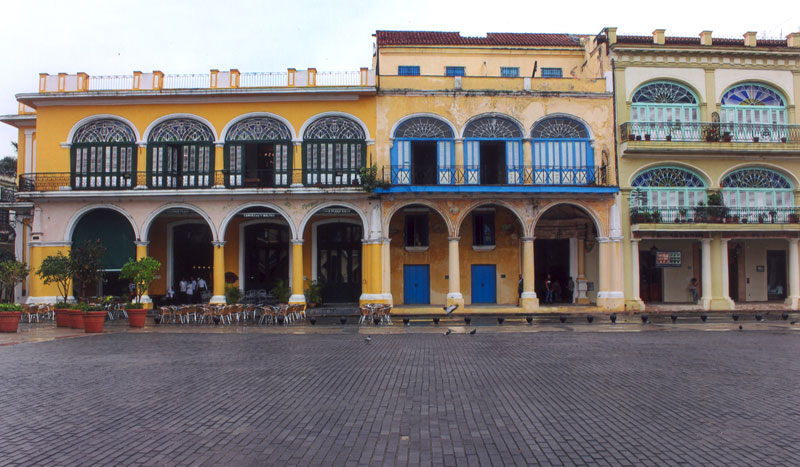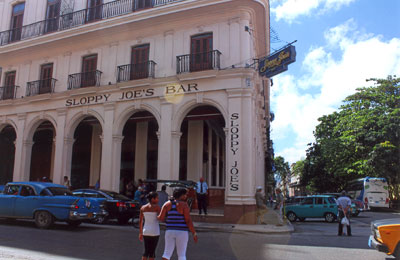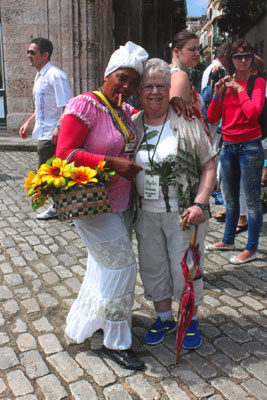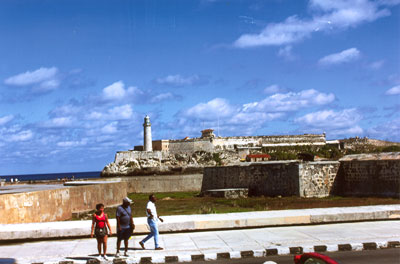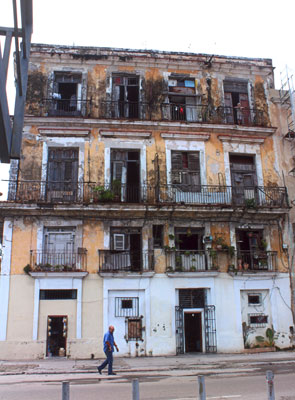Cuba – a long weekend in Old Havana
This article appears on page 6 of the June 2014 issue.
by Bob Henson; Birmingham, AL
The last time I saw Havana was in 1959, when I was sent to “Gitmo” with a US Navy Air Group. That was a long time ago, but when my wife, Phyllis, and I arrived there with an Insight Cuba group on Feb. 27, 2014, it seemed that little had changed — same cars, same crumbling stone buildings, same crowded, potholed streets.
Making plans
Only recently has there been a mechanism in place to allow US tourists to travel to Cuba and, equally important, reenter the US legally. A limited number of American firms has been able to arrange the 2-way trips via a licensing agreement between the US Department of the Treasury and the Cuban government. We chose one of these companies, Insight Cuba (New Rochelle, NY; 800/450-2822), booking their 4-day tour with people-to-people interaction and cultural enrichment ($2,695 per person).
Our group departed Miami International Airport at about 8:30 a.m. after a briefing on what we should expect to see, do and eat over the next four days. Since there is a very extensive embargo of goods and services between Cuba and the US, the only way for American tourists to get there from the US is on a chartered flight ($550 round trip from Miami).
The check-off list of what a visitor to Cuba needs to do is fairly extensive.
First, you must work with your travel agent to assemble your documents. You must have a US passport. The agent will secure an entry permit (in lieu of a visa) for you.
You must also subscribe to a specific level of health insurance. You must fly their charter arrangements, and you have to have a copy of the tour operator’s US Treasury license and pledge to follow the content, spirit and intent of the people-to-people cultural program as approved.
Evidence of any required vaccinations must be provided along with a letter of authorization from the travel group, indicating that you may engage in their approved program under their license.
Restrictions
Baggage on our flight was limited to 44 pounds (two bags) per person, with severe monetary penalties for any overage. Travelers are limited to no more than $800 worth of nonfood parcels.
A heads up — tipping is expected, as it is a major source of revenue to Cuba’s citizens.
There is currently a limit of $188 on daily spending for accommodations and the acquisition of goods for personal consumption.
You cannot use US credit or debit cards in Cuba, so take enough cash with you to last through your trip.
US cell phones do not work in Cuba. You can rent a phone at the airport from CUBACEL that can be used to make local and international calls.
Electrical current is 220 volts in most hotels.
You cannot legally purchase cigars (except to smoke in Cuba), and if you buy local rum or any other alcoholic beverage, you must consume it before returning to the US.
All purchases of goods in Cuba must be made in Convertible Cuban Pesos (CUCs). The exchange rate is one CUC to one US dollar. However, you must pay a 10% commission to exchange dollars to CUCs and 10% to change CUCs back to dollars. This can get expensive!
There are other idiosyncrasies to entering and exiting the country, including an exit fee of $25. Work closely with your travel agent to make sure you cover all the requirements beyond those listed here.
Also note that you should not drink the tap water or brush your teeth with it in most hotels and restaurants. Use only bottled water or water that has been “treated.”
Very little Internet access is available, except in upscale hotels, and it is very slow.
Then there are things you cannot take into Cuba. Among those are GPS systems, fresh animal products, explosives and nonprescription narcotics.
Again, I emphasize that you should work closely with your travel agent and check for any changes right up until your departure, as this is a fluid environment.
Havana
We arrived at Havana’s José Martí International Airport after a short, one-hour flight. Following a mad scramble through Immigration, baggage claim and Customs, and the obligatory conversion of US currency to Cuban CUCs, we boarded a very nice, air-conditioned bus that took us into the city.
The roads around the airport were congested but paved. There were hundreds of guys wanting to carry our bags, and taxi drivers by the dozens tried to hustle us into their 1950s Chevys, Fords, Studebakers, Buicks and Datsuns.
We headed off to Revolution Square to see statues of the heroes of the many revolutions and wars in which noted Latinos and individual Cubans had taken leading roles. After about one hour there, we had lunch at La Bodeguita del Medio. The food was bland but OK, but the mojitos (Cuba’s rum-based national drink) were refreshing.
After lunch, we had a very enriching visit with a group of artists from the Taller Experimental de Gráfica. Their paintings were colorful and very bold. We also appreciated our visit with the local artists and musicians at the Afro-Cuban project Callejón de Hamel. The music included salsa and Caribbean beats and was vibrantly enjoyed by our group.
Our accommodation for this 4-day tour was the recently renovated, very nice Hotel Meliá Cohiba (Ave. Paseo entre 1 y 3, Vedado; phone 53 7 833 3636), located on the waterfront. The hotel had a nice gift shop with plenty of tourist trinkets and T-shirts plus a very exclusive shop with what appeared to be very fine, expensive jewelry, though this shop was never open for business when we were in the hotel.
The food at the hotel was abundant and well presented, and service was adequate (not excellent). Our room was clean, well appointed and relatively large, with an in-room safe for us to use. The bed was big but hard, and the bathroom plumbing was clogged and noisy, but, as tired as we were after a long day, we had no problem sleeping soundly.
An afternoon of art
After a hearty breakfast on our second day, we visited with the students and a professor of La Escuela Taller Gaspar Melchor de Jovellanos, a school where more than 400 teenagers and students in their early 20s were being trained to renovate the infrastructure of Havana and the surrounding area.
We saw young people being taught skills in bricklaying, plastering, concrete pouring, carpentry, painting, sculpting, woodcarving, furniture repair and the welding and smelting of metals.
The professor said that more than 600 of these craftsmen, artisans and artists were busily employed by the government in Havana to repair, preserve and upgrade many of the rapidly deteriorating buildings and apartments throughout the city.
These students earn a small stipend plus college credits and the goodwill of the citizens as they slowly try to preserve their heritage.
We then visited with the director of Fototeca de Cuba to see some of the latest innovations in the integration of drawing, painting and technology being employed by this very talented group. Their specialty is creating pictures that exhibit three different scenes on one canvas, the image changing when viewed from left, right and head on. Other members of the group did clever and quite beautiful work in papier-mâché and cartooning.
After lunch at La Mina, we toured a very modern, well-equipped recording studio owned and sponsored by the Cuban government for the purpose of promoting Cuban music for both local consumption and export.
The facility is government subsidized, so the daily rent and usage fees are less than $100 per day. All of the equipment was imported, and many instruments are available for musicians to use at no cost. The studio provides services to artists up to the cutting of a fully mixed CD.
Dinner was on our own at a local paladar.
A co-op and a choir
Our third day began with an interesting discussion and interactive session with a local political science professor on US-Cuba relations. We were cautioned to keep politics on the sideline but were encouraged to debate possible solutions to the problems presented.
We continued our cultural enrichment by visiting the UBPC Organopónico Vivero Alamar, an organic farm run by a local co-op where numerous fresh crops are grown in soil enriched by animal manure, hay and earthworms. Along with the creation of these essential elements, they raise crops to sell in the local markets and neighborhoods to support their co-op of more than 160 adults and children and run a school and a small medical clinic.
The manager and director of all operations on the farm is the granddaughter of the original land owner. She is now a government employee.
You may recall that Ernest Hemingway was one of the more famous frequent visitors to Havana. We had lunch at one of his “10 daiquiris a day” hangouts called Sloppy Joe’s.
Afterward, we were given the opportunity to interact with members of the National Choir of Havana, a culture-exchange group known worldwide for the very high quality of its musical talent as well as for its superb harmony of voices and for keeping alive the great musical heritage of their homeland. They sang at least 10 pieces for our group — as a full choir and with trio and solo performances — and were enthusiastically rewarded with accolades and applause.
Their leader was very articulate in her discussions with us about the choir’s value to Cuba as a nation.
We had a lovely farewell dinner that included sushi and shaved eel. After a hearty breakfast and the usual end-of-tour distribution of gratuities, we departed for José Martí International Airport. With fond good-byes among the group members and an incredibly difficult, long wait at Miami’s Immigration and Customs, we all went our separate ways, pondering what we had seen and how time has passed up one of the New World’s oldest cities, stranding so many good souls.

